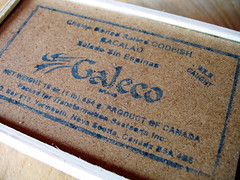You don't want your bed skittering out from under you, do you? Or chafing dish goblins jumping about your weary head? Then you'd better quit ladling welsh rarebit into your greedy gullet before you tuck in for the night. A small piece of cake with a modest spoonful of chamomile-honey crème anglaise is a more restful little something between dinner and bed.
There are several recipes for chamomile crème anglaise wafting through the internets, but I improvised based on this recipe for a lavender one. I made it with lavender a while back and enjoyed it, and I like that it uses milk rather than half-and-half (or light cream, if you're outside the U.S.). Crème anglaise is basically a cold, thin custard and half-and-half does give it a very nice texture, but this time around I was really just looking for a vehicle for the flavor of chamomile, and milk is fine for that.
As for the cornmeal cake, there are hundreds upon hundreds of different recipes out there and I feel like I've tried maybe a third of them. Some use ground nuts in the batter, some use olive oil rather than butter, some specifically call for polenta rather than cornmeal, etc. I am pretty well settled on the recipe below because the somewhat-scary number of egg yolks give it an amazing texture. It may look a bit bread-y in my photo, but the taste is unmistakably, unequivocally cake.

The original recipe for the cake is here. I haven't changed anything about the cake itself; I only fiddled with the syrup. I did rewrite the directions because you definitely don't need to use an electric mixer. The rosemary syrup is really good, though, so do try it some time. The honey syrup I replaced it with is not absolutely necessary, and if you don't want to go buy a bottle of honey liqueur I suppose you could try a simple syrup of 2 tablespoons honey and 2 tablespoons water, heated just until runny.
cornmeal cake with honey syrup
8 servings
cake:
1 stick (1/2 cup) unsalted butter, softened
1 cup sugar
1 cup yellow cornmeal [the best quality you can get your hands on, hopefully Anson Mills; the texture really does make a difference]
3/4 cup all-purpose flour
1 teaspoon baking powder
3/4 teaspoon salt
2 large eggs
1 large egg yolk
2/3 cup milk
honey syrup:
3 tablespoons honey liqueur (I used Bärenjäger)
1 tablespoon mild honey, such as clover
Preheat the oven to 350°F, with the rack positioned in the center. Generously butter an 8- by 2-inch round cake pan. (Possibly I am just paranoid after a bad experience with a sticky cake around Christmas time, but I used nearly a tablespoon of butter for the pan. We're fat now but the cake didn't stick.) Once the pan is buttered, give it a very light dusting of flour (i.e., put a tablespoon or so of flour in your smallest mesh sieve and tap that about over the pan, working fast, so that the entire interior surface is evenly but very lightly coated).
In a large bowl, beat the butter and sugar with a pastry blender "until light and fluffy." This is a standard phrase in cake recipes and I've always understood it to mean that the butter and sugar need to be thoroughly integrated, with no visible streaks of either remaining in the bowl:

Add the remaining cake ingredients and beat everything together until thoroughly combined into a pale yellow batter.
Pour the batter into the pan and bake for 40 minutes. (The original recipe says to bake it "until a tester comes out with a few crumbs adhering.")
Cool the cake in its pan on a rack for 10 minutes.
While the cake is cooling, heat the honey liqueur and the honey in a small saucepan (preferably one with a spout for pouring) just until warmed through and very runny.
Invert the cake onto a plate and, while it is still warm, pour the honey syrup evenly over the surface. I've been keeping the cake at room temperature and I'm convinced the small amount of alcohol kills all cooties, but you can refrigerate it if you're nervous.
chamomile-honey crème anglaise
2 cups milk
4 egg yolks
1/2 cup mild honey (I used raw clover honey)
3 chamomile tea bags, or the equivalent amount of loose chamomile tea
Heat the milk and the chamomile tea bags (or loose tea) in a heavy saucepan over medium heat until the milk starts to bubble around the edges of the pan. (A heavy pan — such as enameled cast iron — is ideal because milk can easily get too hot too fast in a cheapo pan). Turn the heat off and let the chamomile steep in the warm milk for approximately 20 minutes.
After 20 minutes or so, heat the milk again over medium heat. If it appears to have reduced quite a bit since the first time around, you can add a splash more to the pan.
While the milk is heating a second time, whisk the egg yolks and the honey together until they are very thoroughly blended.
Remove the tea bags from the pan. (If you've used loose tea, leave it in, and see note below about straining).
Once the milk has again started to bubble at the edges, whisk 1/2 cup of it into the egg yolk and honey mixture. Whisk constantly but not too vigorously; the purpose of this step is to get the egg yolk mixture acclimated to the temperature of the milk, not to get it to change texture. Pour the egg yolk mixture into the pan and keep whisking for approximately one minute, or until the mixture thickens slightly. "Slightly" is all you're looking for: Once it is thick enough to coat the back of a spoon, it's done, and you can take the pan off the heat. Transfer the crème anglaise to a bowl or pitcher and refrigerate until chilled. (If you have used loose chamomile, now is the time for you to pass the crème anglaise through a mesh sieve). It will taste just as good, if not better, the next day. If a skin has formed on the surface of the crème anglaise while chilling, remove it with a spoon before serving.
If you think the cake will be too naked with just a little crème anglaise on it, I think a spoonful of sautéed apples (maybe with a little honey, fresh thyme, and lemon juice?) would be nice on the plate. Fresh berries would work too. Candied walnuts or pecans wouldn't be out of place either.


























